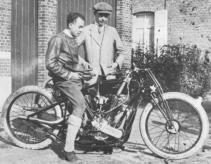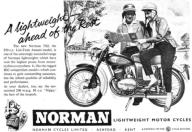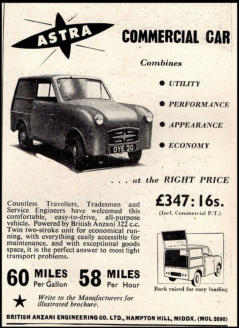
british anzani archive:

Towards the end of it’s existence it was also sold in kit form with or without body
parts for home assembly.
As sales slowed production was taken over by Gill Cars of Paddington who
produced two new cars based on the Astra chassis and mechanical parts: a two
seater coupe called the Getabout and a saloon. After a short and not very
successful career production ceased in 1959 although there is evidence of sales
into 1960.
Among other cars that used the
Anzani 322cc engine at that time
was the Powerdrive. This sporty
looking 3-wheeler made in Wood
Green, north London made it’s
debut in July 1955 and retailed for
£330 plus purchase tax. The
engine was mounted in the rear
driving the rear wheel through a
chain drive. It had a 3-speed
gearbox and independent front suspension and could seat three across it’s
bench seat. The Powerdrive’s 65mph/65mpg performance claim and it’s good
looks and generous space and comfort made an immediate impact.
The very pretty Berkeley Sports of 1956 initially used an Anzani 322cc 15hp
engine to produce it’s 70 mph/60 mpg performance while Fairthorpe also had an
Anzani in their ‘Atom’ and Peel used the 250cc version in their 1955 ‘Manxcar’.
The 1956 Laurie Bond
designed Unicar also had the
ubiquitous 322cc Anzani
onboard. Built by S.E.
Opperman of Boreham Wood
these small saloons provided
family motoring for £399 10s
0d. Capable of 60mph/55mpg performance from its rear mounted Anzani the
glass fibre bodied saloon was more of 2+2 than a genuine four seater. With it’s
6’ wheelbase the tiny saloon was another interesting development of the
ultralight economy car trend of the 1950’s.
Outboard motor production became Anzani’s biggest selling (and perhaps best
known) item over the years and numerous models were produced: the Minor
(1955-79) a small ½hp general purpose dinghy motor, Super Single (1942-79
158cc, 5hp) the engine that was produced for the longest time and arguably the
best known - another general workhorse. Jet (Single, 60cc, 3hp) a fibre glass
cowled engine with ‘guarded drive’ protection for swimmers etc, Sports Twin
(1950-51) 316cc 14hp, speedy but short lived, Unitwin (1951-67 Twin, 242cc
10hp, and 322cc 15hp, plus full race versions of both) the most advanced
engine of it’s day, powerful
and reliable, Pilot (Single,
60cc, 2.5hp) another general
purpose engine with the
distinguishing bar around the
cowl, Seamaid (Single, 60cc
3hp) fibre glass cowled
general purpose engine,
Startwin (1960 Twin, 344cc,
18hp) renamed Magnatwin,
powerful twin featuring
‘Contrastart’ electric start with
instant forward or reverse,
Supertwin 15 (Twin, 322cc,
15hp) streamlined fibre glass
cowled Unitwin, Fleetwin 20
(Twin, 344cc, 20hp), Triton
(1960 3 cylinder 30hp,
492cc), Magnatwin (1958-
1960 Twin, 344cc, 18hp) a
large electric start model
which could be remotely
controlled, Model 65 (1964-67
6.5hp), Model 180 (1964-67
18hp), Model 400 (1964-67
40hp) which were the
Oliver/Perkins engines. There
was also an inboard version
of the 4hp Super Single
called the ‘Dinghy Motor’
(1952).
The production of outboard motors was given a fillip in 1964 when the Company
bought the remnant of the Chris-Craft/Oliver marque which they acquired from
the car makers Rootes Group.
In 1959 Perkins had come to an arrangement with the US company Oliver to
manufacture their range of outboards in the UK. The American designs were















